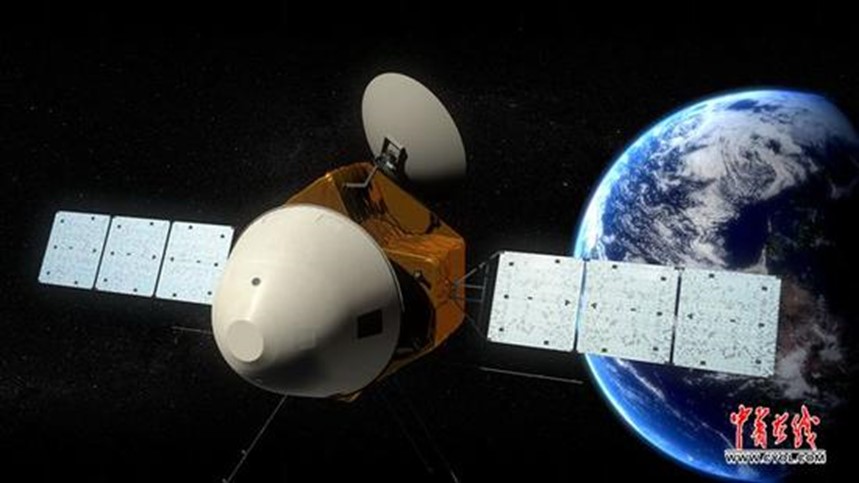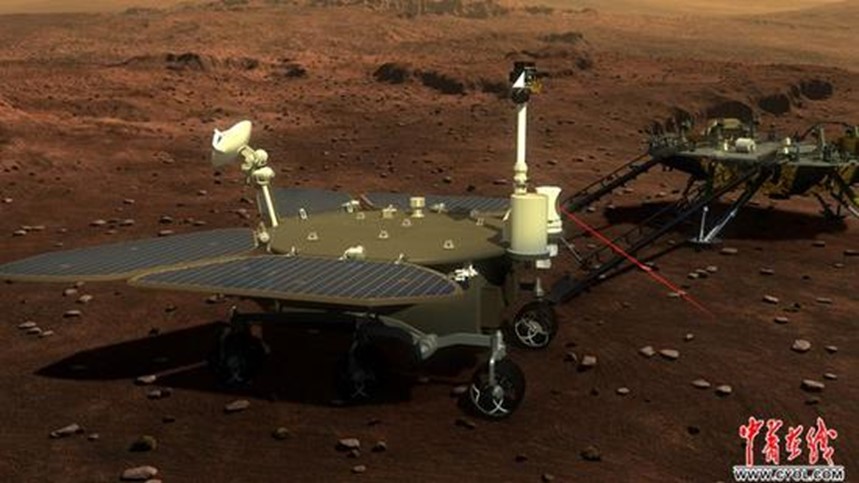
Design Configuration Diagram of China's First Mars Probe Appearance
On August 23, “The Global Solicitation of China Mars Exploration Project’s Name and Graphic Identity” press conference held in Beijing, first announced Chinese first martian lander and rover design configurations. Before this, Chinese State Administration of Science had declared that Chinese first martian mission will be carried out in 2020 to achieve the goals of “circling, landing and roving” in one step.
Mars is one of planets in the solar system which is close and has a similar natural environment to our Earth, hence it is the preferred choice in planetary explorations. Limited by the planetary motions, launching opportunity of martian probes occurs every 26 months. Upcoming four Mars missions in three launch opportunities from now to around 2020 will be a peak period of international martian explorations.
In the speech, Jizhong Liu, deputy commander of Chinese first martian mission and director of lunar exploration and aerospace engineering center, said that "Chinese first martian mission will achieve global remote sensing and breakthrough of key technologies such as entry, descent, landing, roving, remote measurement, control and communications, and make us approach Mars and unveil her mysteries, which will be a pride of Chinese".
Rongqiao Zhang, chief designer of Chinese first mission to Mars, mentioned that the three goals, "circling, landing and roving", achieved at one mission had never been done previously, and the challenges are unprecedented.

Concept picture of Chinese Mars Lander
Mars is as far as 400 million kilometers from Earth, Zhang said, after separating from the rocket, Mars probe will take about seven months to cruise prior to be captured by Mars. Then, the orbiter will begin global observations in the nominal orbit around Mars, and serve for relay communication with lander at the same time, thus we need to consider requirements of both circling and landing in the orbital design.
After separation from the orbiter, the lander will enter the martian atmosphere, go through aero-maneuvering, parachute deceleration and powered descent, and finally land on martian surface. Then the rover will drive away from the lander, starting roving investigations include morphology, soil, environment, atmosphere, distribution of water ice, physical field and internal structure, Zhang said.
Due to the long-time delay of remote data transmission, martian rover must have a high degree of autonomy. Meanwhile, the solar irradiance on Mars is lower than the Moon and is reduced by the martian atmosphere. Thus, energy supplies of martian rovers are more difficult than lunar rovers. Zhang said, "All of these make Chinese first Mars missions more difficult and complex. Nevertheless, we still have the faith of success! ".
This Global Solicitation Activity was hosted by Lunar exploration and aerospace engineering center, State Administration of Science, China, co-organized by Public information center, State Administration of Science, China, Department of General lunar and deep space explorations, Chinese Academy of Sciences, Astronavigation sector, China Aerospace Science and Technology Group, China Academy of Launch Vehicle Technology, Chinese Academy of Space Technology, Shanghai Academy of Spaceflight Technology, China, etc., and undertaken by Chang’e-benyue Aerospace Science and Technology (Beijing) Co., Ltd., China, Zhongxuan International Communications Group, Xinhua Net Co., Ltd., China, TenCent Science and Technology (Beijing) Co., Ltd., China, TAG Heuer, Swiss, etc.

Concept picture of Chinese Mars Rover